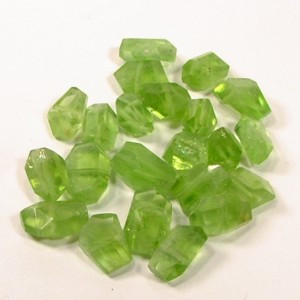Although blue topaz and zircon are the most well known birthstone associated with December, many other stones are also considered to represent the month. The theme of all well known December birthstones is the color blue, with other representative stones being tanzanite, and turquoise. We will give some facts about a couple of the assigned birthstones below.
Topaz itself comes in many different colors, and it is the accepted gem of the 4th, 19th, and 23rd wedding anniversaries. Most topaz is found in Brazil, Sri Lanka, Russia, Australia, Africa, Mexico and Pakistan, and is found naturally very pale in color. The gem is then irradiated to produce more intense colors.
Turquoise
Turquoise has been mined since the Early Egyptians’ time of 6000 B.C., and is known as the most v aluable non transparent minerals used in jewelry trade. The finest turquoise is found in Iran, but can also be found in the southwestern United States. It is known as a sacred stone for the North American Indians and Tibetans, often used in rituals and ceremonies. Turquoise is thought to promote mental and spiritual clarity and enhances wisdom, trust, kindness and understanding.
aluable non transparent minerals used in jewelry trade. The finest turquoise is found in Iran, but can also be found in the southwestern United States. It is known as a sacred stone for the North American Indians and Tibetans, often used in rituals and ceremonies. Turquoise is thought to promote mental and spiritual clarity and enhances wisdom, trust, kindness and understanding.
Tanzanite
Tanzanite has only been deemed a December birthstone since 2002, when it was officia lly named to represent the month. Tanzanite was first discovered in 1967 in Tanzania, East Africa. It is one of the newest and most exotically colored gemstones, and can only be found in Africa. Tanzanite is a brittle stone and although it can be worn daily, be careful not to hit it against hard surfaces, or expose it to extreme temperature changes. It is not advised to clean it in an ultrasonic cleaner. Because this is such a new stone, there is not much folklore attached to it, but it is said to have been discovered by cattle herders after lightening burned areas around the stone in Tanzania.
lly named to represent the month. Tanzanite was first discovered in 1967 in Tanzania, East Africa. It is one of the newest and most exotically colored gemstones, and can only be found in Africa. Tanzanite is a brittle stone and although it can be worn daily, be careful not to hit it against hard surfaces, or expose it to extreme temperature changes. It is not advised to clean it in an ultrasonic cleaner. Because this is such a new stone, there is not much folklore attached to it, but it is said to have been discovered by cattle herders after lightening burned areas around the stone in Tanzania.




















